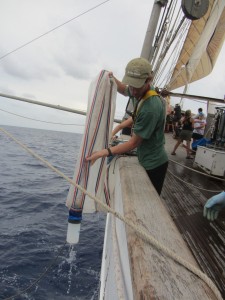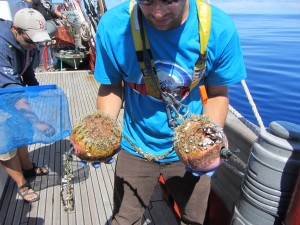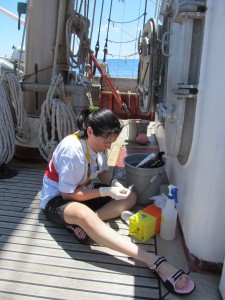24 February 2014
HONOLULU – Scientists are revealing how microbes living on floating pieces of plastic marine debris affect the ocean ecosystem, and the potential harm they pose to invertebrates, humans and other animals. New research being presented here today delves deeper into the largely unexplored world of the “Plastisphere” – an ecological community of microbial organisms living on ocean plastic that was first discovered last year.

SEA Education Association student Ethan Edson pulls aboard a net with samples of plankton and plastic. Researchers from SEA, Woods Hole Oceanographic Institution and the Marine Biological Laboratory discovered the Plastisphere, an ecological community of microbial organisms living on ocean plastic, last year, and are presenting additional findings about these communities at the Ocean Sciences Meeting.
Credit: Erik Zettler, SEA
When scientists initially studied the Plastisphere, they found that at least 1,000 different types of microbes thrive on these tiny plastic islands, and that they might pose a risk to larger animals, including invertebrates and humans. The original studies also showed that the Plastisphere’s inhabitants included bacteria known to cause diseases in animals and humans.
Since then, researchers have been trying to figure out why these potentially dangerous bacteria live on the Plastisphere, how they got there and how they are affecting the surrounding ocean.
New evidence suggests that “super-colonizers” form detectable clusters on the plastic in minutes. Other findings indicate that some types of harmful bacteria favor plastics more than others. And, scientists are exploring if fish or other ocean animals may be helping these pathogens thrive by ingesting the plastic. That could allow bacteria to acquire additional nutrients as they pass through the guts of the fish, said Tracy Mincer, an associate scientist at Woods Hole Oceanographic Institution in Woods Hole, Mass.

SEA Education Association scientist Greg Boyd holds recovered foam floats containing invertebrates and microbial biofilm. New research being presented at the Ocean Sciences Meeting delves deeper into the role microbial communities living on plastic marine debris play in the ocean ecosystem.
Credit: Erik Zettler, SEA
Revealing this information could help scientists better understand how much of a potential threat these harmful bacteria pose and the role the Plastisphere plays in the larger ocean ecosystem, including its potential to alter nutrients in the water. That information could also help reduce the impact of plastic pollution in the ocean – for instance, if plastics manufacturers learned how to make their products so they degrade at an optimal rate, Mincer said.
“One of the benefits of understanding the Plastisphere right now and how it interacts with biota in general, is that we are better able to inform materials scientists on how to make better materials and, if they do get out to sea, have the lowest impact possible,” said Mincer, who discovered the Plastisphere last year along with Linda Amaral-Zettler at the Marine Biological Laboratory (MBL) and Erik Zettler at the SEA Education Association, both also in Woods Hole.
The Plastisphere team is presenting their latest research on these communities today at the 2014 Ocean Sciences Meeting, which is co-sponsored by the Association for the Sciences of Limnology and Oceanography, The Oceanography Society and the American Geophysical Union.

Marine Biological Laboratory scientist Linda Amaral-Zettler prepares recovered foam floats to be analyzed for Plastisphere microbes.
Credit: Erik Zettler, SEA
Other new results include discoveries about how the plastic is colonized and how it interacts with other marine organisms. Yet additional findings shed light on the similarities and differences between Plastisphere communities in different locations and on different types of plastic. This research could help scientists determine the age of plastic floating in the ocean, which could help them figure out how it breaks down in the water. It could also potentially aid in determining where the plastic debris came from, and how the plastic and the microbes that live on board could impact organisms that come into contact with them, the scientists said.
“It is clear,” said Amaral-Zettler, “that the Plastisphere definitely has a function out there in the ocean” and these experiments seek to quantify what it is.
Notes for Journalists:
The researchers on these studies will present oral presentations about their work on Monday 24 February 2014 at the Ocean Sciences Meeting. The meeting is taking place from 23 – 28 February at the Hawaii Convention Center in Honolulu. For more information for members of the news media, please go to http://www.sgmeet.com/osm2014/media.asp.
Below are abstracts of the presentations. The presentations are part of Session 140: The Science of Plastic Marine Debris and other Anthropogenic Influences being held Monday 24 February from 8 a.m. to 12:30 p.m. local Hawaii time in room 316 B.
Title:
Comparative Microbial Community Structure and Biogeography of Atlantic and Pacific “Plastisphere” Communities
Oral presentation
Session #:140
Date: 24 February 2014
Time: 10:30 a.m.
Location: 316 B
Authors:
Amaral-Zettler, L. A., Marine Biological Laboratory, Woods Hole, MA, USA;
Boyd, G., Sea Education Association, Woods Hole, MA, USA;
Slikas, B., Marine Biological Laboratory, Woods Hole, MA, USA;
Zettler, E. R., Sea Education Association, Woods Hole, MA, USA;
Mincer, T. J., Woods Hole Oceanographic Institution, Woods Hole, MA, USA.
Abstract:
Plastic Marine Debris (PMD) is the most abundant form of marine debris found in all of the ocean’s gyres. The Plastisphere is defined as the thin layer of life found on the outer surface of PMD. Plastisphere microbial communities on microplastics (<5 mm) collected from open ocean surface waters are distinct from the surrounding seawater and harbor a diversity of microbial species including potential pathogens. However, the variability of the Plastisphere over space and time remains underexplored. We completed collection and next-generation amplicon sequencing of 16S rRNA gene V6 hypervariable regions on samples from two open-ocean transects in the North Atlantic Subtropical Gyre and the North Pacific Subtropical Gyre, giving us good data sets for comparing regional differences within and between oceans. Our data reveal that many of the same bacterial Operational Taxonomic Units (OTUs) inhabit the Plastisphere of Atlantic and Pacific gyres, but dominant OTUs are often distinct on different pieces of plastic regardless of ocean basin. Our sampling strategy allows us to compare and contrast Plastisphere biogeography along marine longitudinal and latitudinal gradients.
Title:
Microbial Succession on Plastic Marine Debris: Development of the “Plastisphere” Community
Oral presentation
Session #:140
Date: 24 February 2014
Time: 10:45 a.m.
Location: 316 B
Authors:
Zettler, E. R., Sea Education Association, Woods Hole, MA, USA;
Morrall, C., St. George’s University, Grenada, West Indies;
Proskurowski, G., University of Washington, Seattle, WA, USA;
Mincer, T. J., Woods Hole Oceanographic Institution, Woods Hole, MA, USA;
Amaral-Zettler, L. A., Marine Biological Laboratory, Woods Hole, MA, USA.
Abstract:
Recent studies have revealed a diverse microbial community on plastic marine debris in the Atlantic and Pacific oceans, the so-called “Plastisphere”. How this community develops over time on different types of plastic and in different geographic areas of the world ocean is unknown. We immersed sterile polyethylene, polypropylene, polystyrene, and glass samples in temperate (Woods Hole, MA, USA) and tropical (St. Georges, Grenada) coastal surface waters, and then monitored the development of microbial communities on these substrates using quantitative counts of scanning electron micrographs and next-generation amplicon sequencing. A variety of pennate diatoms colonized plastic marine debris within the first week and diatoms dominated the early communities in both locations, followed by bacteria. Over time the community changed and other groups such as sessile ciliates colonized the plastic. Communities on expanded polystyrene developed more slowly than on the other substrates, and total coverage increased more quickly in temperate waters than tropical waters. Changes in the diversity and composition of communities over time may provide clues to the age of plastic marine debris, which is currently difficult to determine.
Oral presentation
Session #:140
Date: 24 February 2014
Time: 11:00 a.m.
Location: 316 B
Authors:
Mincer, T. J., Woods Hole Oceanographic Institution, Woods Hole, MA, USA;
Guzzetta, V. S., DePauw University, Greencastle, IN, USA;
Slikas, B., Marine Biological Laboratory, Woods Hole, MA, USA;
Zettler, E. R., Sea Education Association, Woods Hole, MA, USA;
Amaral-Zettler, L. A., Marine Biological Laboratory, Woods Hole, MA, USA.
Abstract:
Plastic Marine Debris (PMD) persists much longer than any natural floating substrate and provides an attachment surface for thin layers of life (termed the Plastisphere). Our previous amplicon sequencing surveys of 16S rRNA genes have shown that Bacteria of the genus Vibrio can comprise a major portion of the Plastisphere – at times nearly 25% of the bacterial community. We adapted a 96-well plate format biofilm quantification assay to survey over 50 Vibrio spp. cultivars for attachment ability to various plastic resins. Some vibrios demonstrated cell density-dependent attachment and/or a preference for plastic resin type. Strikingly, ‘super-colonizer’ vibrios were discovered to form measureable biofilms on plastic in a matter of minutes. In general, biofilm formation phenotypes clustered within Heat Shock Protein 60 (HSP 60) gene phylogenies. We generated a metagenomic dataset of a Vibrio-dominated PMD sample and analyzed it for key adherence and virulence genes. Characterizing Vibrio attachment to plastic will provide a model for PMD colonization and clues to the ecological function of this prevalent group of Plastisphere inhabitants.
Contact information for the researchers:
Erik Zettler, +1 (508) 360-8384, [email protected]
Linda Amaral-Zettler, +1 (508) 292-5990, [email protected]
Tracy Mincer, +1 (619) 507-8129, [email protected]
Mary Catherine Adams
+1 (202) 412-0889
[email protected]